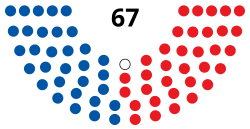Minnesota State Senate
| Minnesota Senate | |
|---|---|
| 90th Minnesota Legislature | |
 |
|
| Type | |
| Type |
Upper house of the Minnesota Legislature
|
|
Term limits
|
None |
| History | |
|
New session started
|
January 3, 2017 |
| Leadership | |
| Structure | |
| Seats | 67 |
 |
|
|
Political groups
|
|
|
Length of term
|
4 years when elected in years ending in 2 and 6. 2 years when elected in years ending in 0. |
| Authority | Article IV, Minnesota Constitution |
| Salary | $31,140.90/year + per diem |
| Elections | |
| First-past-the-post | |
|
Last election
|
November 8, 2016 |
|
Next election
|
November 3, 2020 |
| Redistricting | Legislative control |
| Meeting place | |
 |
|
| Senate chamber Minnesota State Capitol Saint Paul, Minnesota |
|
| Website | |
| www |
|
The Minnesota Senate is the upper house of the Legislature of the U.S. state of Minnesota. There are 67 members, half as many as the Minnesota House of Representatives. In terms of membership, it is the largest upper house of any U.S. state legislature. Floor sessions are held in the west wing of the State Capitol in Saint Paul.
Offices of members are located north of the State Capitol in the Minnesota Senate Building, where the Senate holds committee meetings.
Due to the restoration process of the State Capitol taking place since 2014, the Senate held floor sessions in 2016 in the Minnesota Senate Building, an office building across the street north of the State Capitol. It was the first time the Senate held a regular session outside of the State Capitol since its opening in 1905.
In addition to its legislative powers, certain appointments by the governor are subject to the Senate's advice and consent. Appointees may serve without being confirmed by the Senate, unless the Senate rejects the appointment.
Each Senate district includes an A and B House district (e.g. Senate district 41 contains House districts 41A and 41B). The Minnesota Constitution forbids a House district to be within more than one Senate district. Before the 1960s, senators were apportioned by county, resulting in the underrepresentation of those in cities. In order to account for decennial redistricting, members run for one two-year term and two four-year terms each decade. They are elected for four-year terms in years ending in 2 and 6, and for two-year terms in years ending in 0. Districts are redrawn after the decennial United States Census in time for the primary and general elections in years ending in 2. The most recent election was held on November 8, 2016.
...
Wikipedia
